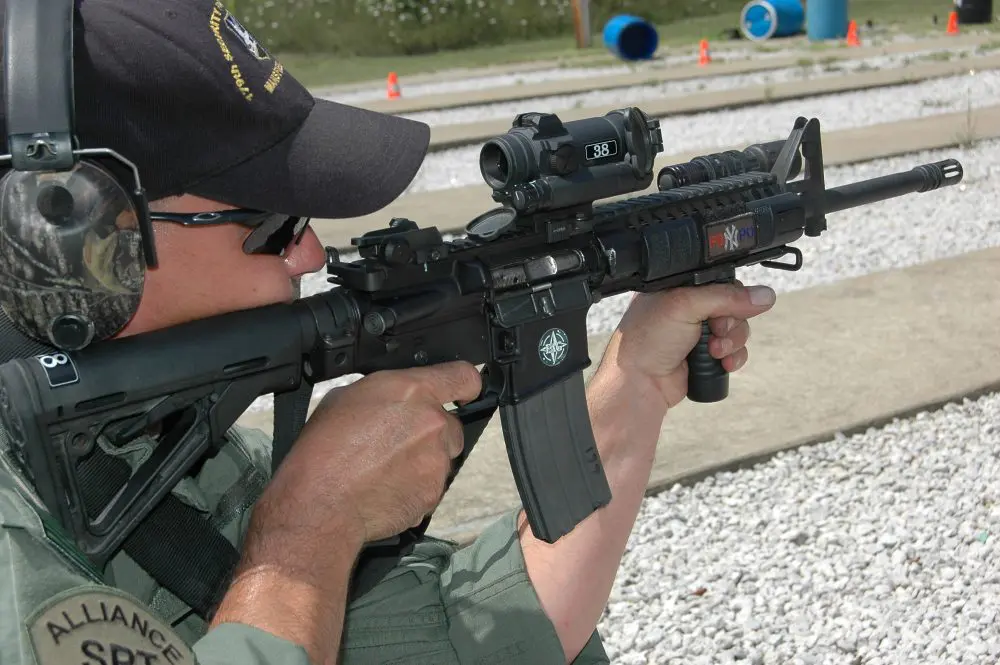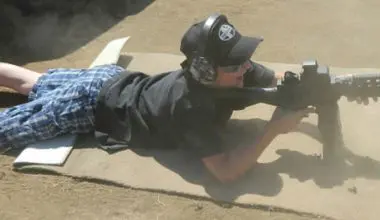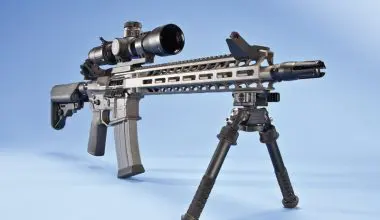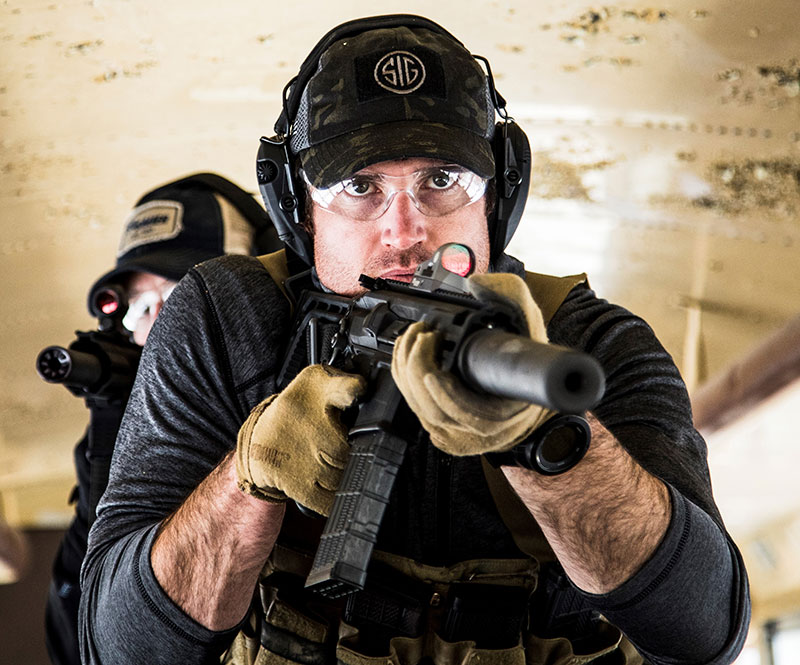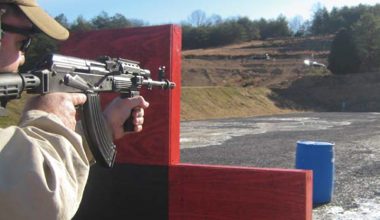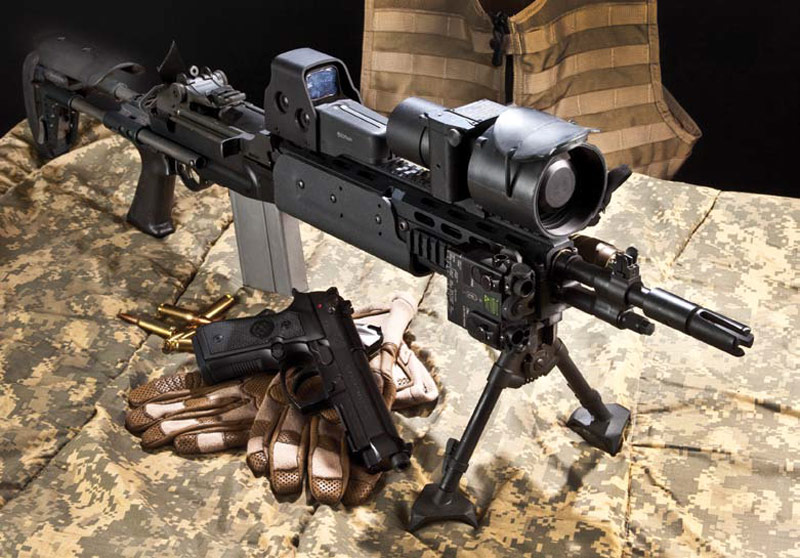
The M4 has also proven to be less than reliable in The Sandbox, where sand the consistency of talcum powder gets into everything, causing the M4 to have more than its share of stoppages, according to reports from the troops.
The military’s first response was to begin taking M14 rifles from storage, because the 7.62x51mm cartridge’s ballistics far surpass those of any 5.56x45mm round in every respect, plus the M14 doesn’t have the M4’s reliability issues.
But this was a short-term solution, since the basic M14 has some serious issues.
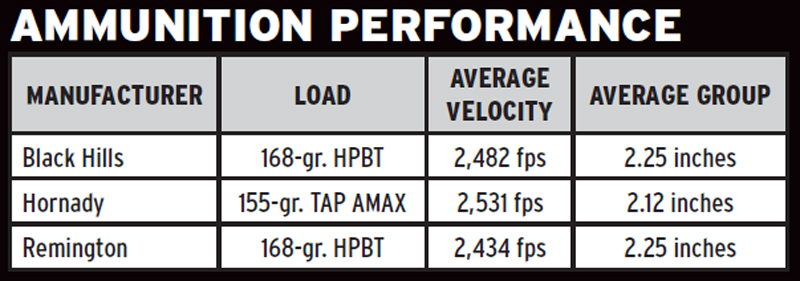
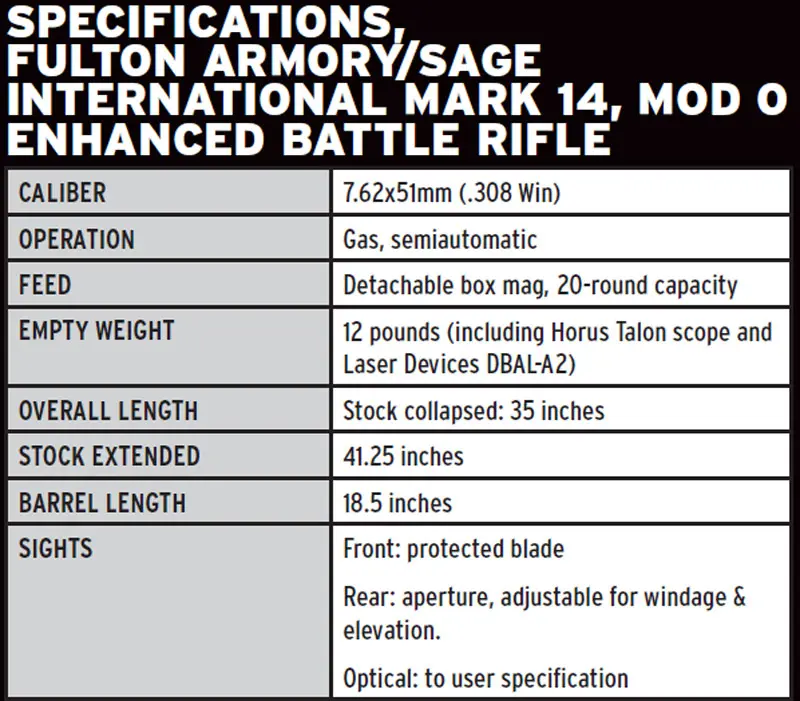
Table of Contents
M14 LIMITATIONS
The M14 is essentially a 70-year-old design, being nothing more than an improved M1 Garand. It is uncontrollable in full automatic fire and has no capability to accept modern accessories such as lasers, white lights, night vision optics and other options considered necessary by special operations forces.
The M14 stock has a fixed length of pull and nonadjustable cheekpiece, a problem because operators wearing body armor and vests loaded with equipment require a fully adjustable stock so they can vary length of pull and height of cheek rest based on mission requirements and installed accessories.
The long-term goal is to replace the M4 with the Special Operations Combat Assault Rifle, or SCAR. There are two versions of the SCAR: Light in 5.56x45mm, 6.8x43mm and 7.62x39mm, and Heavy in 7.62x51mm. The SCAR Light will be fielded first, followed by the SCAR Heavy. Both SCAR versions are modular, but since the SCAR Heavy is some years from being fielded, a modular 7.62x51mm rifle was needed—right now!
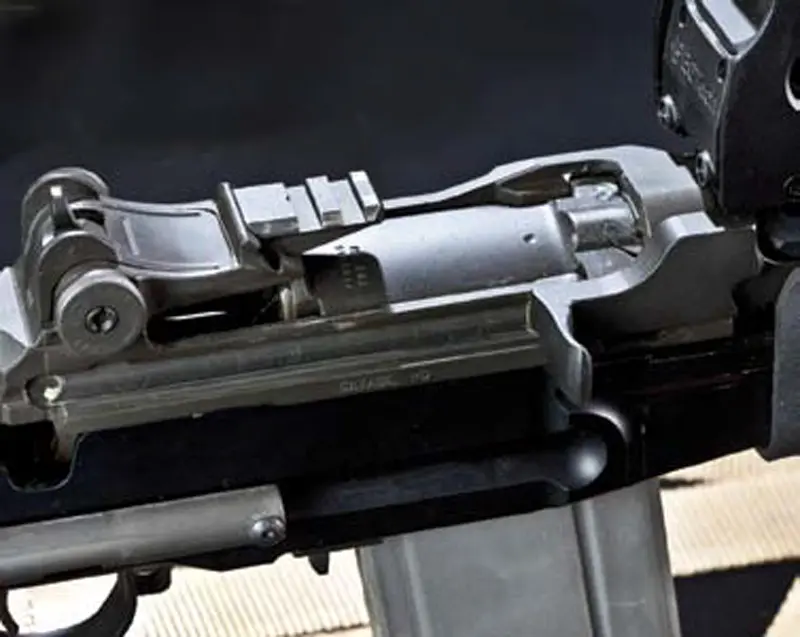
EBR STOCK
Responding to a SOCOM requirement, Sage International developed a chassis-type stock for M14 rifles that completely transforms the old warrior into a 21st century enhanced battle rifle. This stock is now being used to modify M14 rifles at Naval Surface Warfare Center, Crane, Indiana. The result is the Mark 14, Mod 0 Enhanced Battle Rifle (EBR), which is available to the law enforcement market and civilian users by buying a semiautomatic-only Mark 14, Mod 0 “clone” from Fulton Armory.
The Sage International Enhanced Battle Rifle Stock is CNC machined from a solid billet of 6061 T6 aluminum and provides a rock-solid platform for enhanced accuracy, reliability and accessory mounting.

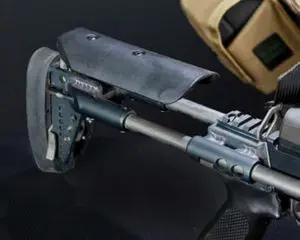
The M14 barreled action sits lower in the EBR Stock than in a standard M14 stock, reducing the tendency of the rifle to climb, because the recoil forces are more in a straight line with the shooter’s shoulder than the original.
The EBR Stock has an adjustable cheekpiece that moves through a full two inches of vertical travel. The retractable stock has six positions, spaced in 1.25-inch increments, measured center to center. The locking recesses are 0.5- inch wide and once locked, will not move. The lock release is disengaged for adjustment by a large spring-loaded central button above the pistol grip. The button can be reached by simply pressing it with the thumb without taking one’s hand off the pistol grip.
Ambidextrous sling mounts are fitted at the front of the handguard, above the pistol grip and at the butt.
Finally, the EBR Stock free floats the M14 barrel, an important feature for enhanced accuracy. Not only does the Sage EBR Stock transform the M14, it is essentially a drop in, with no glass bedding or special fitting required.
There are four MIL-STD-1913 rails on the stock for mounting accessories. The side and bottom rails are approximately half the length of the forearm, while the top rail is full length. A small section of MIL-STD-1913 rail sits over the pistol grip for mounting night vision optics.
The interface between the rifle’s receiver and stock is extremely tight, as Fulton Armory and Sage worked jointly on the commercial version of the Mark 14, Mod 0 to ensure the perfect receiverto- stock interface that is essential for accuracy and reliability, although any milspec M14 receiver will fit the Sage stock.
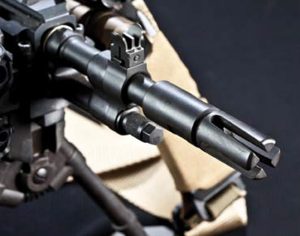
MAINTENANCE
Once converted to Mark 14, Mod 0 configuration, the rifle is neither designed nor intended to be fully disassembled (i.e., have the action removed) on a regular basis. Once the action and barrel are installed in the EBR Stock, they are intended to stay there. This is partly because regular removal and replacement of the barreled action will cause undue wear and tear on the precision interface between the action and stock. Also, because the fit is so tight, the barreled action is difficult to remove. The Mark 14, Mod 0 does not require removing the action from the stock for routine maintenance.
Barrel cleaning of any rifle should be from the breech end to avoid damage to the muzzle, so I recommend that a breech-to-muzzle Otis Cleaning Kit be used. The bolt and op rod can be cleaned and lubricated with the action in the rifle. The trigger housing group can be removed as with any M14, although it is also a tight fit. The gas piston can be removed and the cylinder accessed for gas system maintenance like any standard M14.
TEST RIFLE
Fulton Armory is known for manufacturing high-quality products, and the Mark 14, Mod 0 replica is no exception.
The test rifle provided by Fulton Armory replicates the military-issue Mark 14, Mod 0 in almost every way except that it is semiautomatic only. An option is a nonfunctioning selector switch that makes the Fulton Armory rifle an exact visible replica of the real thing. The receiver is investment cast and the components are a mix of quality commercial and GI parts.
The GI M14 barrel is shortened from 22 to 18.5 inches and the standard M14 flash suppressor replaced by a Smith Enterprises Vortex flash suppressor that reduces flash by approximately 99 percent. The front sight that once sat atop the flash suppressor has been moved to the gas cylinder lock ring.
The bolt stop has been replaced by a “paddle” type similar to that of the M4 carbine. It allows the bolt to be released without removing the trigger hand from the pistol grip, as opposed to the original M14/M1A, which required the bolt handle to be pulled to the rear after a fresh magazine was inserted to release the bolt stop. This addition is a major advantage in combat, where every second counts, not to mention it’s just more convenient! Finally, the clip guide on the receiver has been replaced by a 1.5-inch section of MIL-STD-1913 rail to allow optics to be mounted.
ACCESSORIES
For SWAT or special tactical units, this is a rifle that totally overshadows any 5.56x45mm firearm, while offering the same flexibility and tactical utility. The story doesn’t end with the rifle, although I believe that the Mark 14, Mod 0 is the most significant development of the rifle itself since the M14 was originally designed in the 1950s. The military units that developed the Mark 14, Mod 0 never go on an operational mission with a “bare” rifle, so I set up the test Mark 14 Mod 0 with the latest tactical accessories of all types.
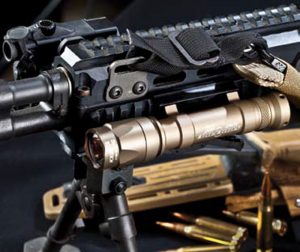
EOTech HWS
The first item I added was the EOTech Holographic Weapon Sight (HWS), which is in widespread use by the U.S. military in Afghanistan and Iraq and also by many law enforcement tactical teams throughout the United States. The HWS, called simply “EOTech” by GI users, is so prolific that you’ll see it in most photographs of NATO troops in action in the War on Terror.
The EOTech projects a hologram onto a hardened glass window. The reticle cannot be seen from the front, even in conditions of darkness, and appears as long as there is a clear view through any part of the window. The HWS is fully night vision compatible with IR reticle settings. Finally the HWS, like all quality red dot sights, is extremely fast on target.
The reason for the widespread adoption of optics is simple. Sighting a carbine with open (iron) sights requires aligning three different elements: target, front sight and rear sight. All that is required with a properly zeroed optically sighted carbine is to superimpose the optic’s reticle on the target and shoot.
Optics also benefit shooters who wear glasses or whose eyes have difficulty focusing on the components that constitute proper iron sight alignment and picture. The military has gone to optical sights for just about every small arm because target engagement is much faster, as are follow-up shots. Another advantage with optics is that all are used with both eyes open, so the shooter can observe and scan for threats while engaging enemy targets.
These benefits are equally applicable to law enforcement officers and private citizens. When the time comes to use his carbine, a police officer or citizen is almost certainly in a high-threat situation where speed equals survival— not just in maneuver, but in target engagement.
AN /PVS-22
One of the most significant developments in night vision technology is Optical System Technology’s AN/PVS-22 Universal Night Sight (UNS).
The UNS mounts ahead of the day optic, so eye relief is no longer an issue, unlike the PVS-14, which must be placed behind the day optic and requires an adapter and IR illuminated reticle. Moreover, since the UNS mounts in front of the optical sight, the day optic’s reticle can be used without illumination. Looking through the day optic and the UNS is almost like daylight, except that the crystal-clear image is monotone and has a green tint. The day optic’s reticle and the rifle’s zero are unaffected.
The UNS can also be used as a handheld night vision optic.
DBAL-A2
I also added a Laser Devices DBAL-A2 (Dual Beam Aiming Laser-Advanced). Laser Devices has a multi-million dollar contract for this device, which the military calls a Multi-Function Aiming Laser System. The DBAL-A2 provides an IR pointer, IR illuminator and visible laser pointer. The DBAL-A2 is constructed of 6061 T6 aircraft aluminum, is 3.7 inches in length, 1.7 inches wide and weighs only eight ounces. Power is from a single AA battery. Modes are selected using a rotary switch to select between the visible laser and the various IR modes, including IR pointer only, IR illuminator only or both. A low power engagement mode reduces the IR output for indoor use and CQB.
When used with the AN/PVS-22, the DBAL-A2 enables the shooter to illuminate his target with a laser that is invisible to the naked eye—a major advantage in night operations.
The DBAL-A2 is provided with optional mounts for MIL-STD-1913 rails— either a thumb screw or ARMS throw lever mount. The test unit came with the ARMS mount, which I personally prefer. Like the AN/PVS-22, the DBAL-A2 is available only to military and law enforcement customers.
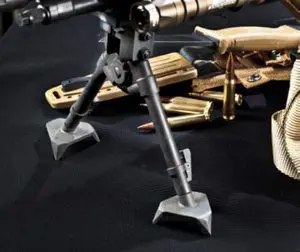
Bipod
The final accessory is special operations’ latest bipod, which was designed in a joint effort by Mike Rock and Keng’s Firearms Specialty. The bipod clamps directly and firmly to the bottom MILSTD- 1913 rail via Mike Rock’s patentpending QD clamp. The QD clamp mechanism is adjustable to accommodate any slack that might occur.
The most visible features of these new bipods are the large patented claws that form the feet of the bipod. The claws are designed to prevent the bipod legs from sinking into soft ground and prevent rifle movement under recoil.
The bipod legs are spring loaded so they can be instantly adjusted with the rifle on the ground by simply pressing the release button and allowing the rifle to rise on its own or by pressing down on it to lower it.
SHOOTING TIME
Shooting is the acid test, and Fulton Armory’s Mark 14, Mod 0 replica lived up to its claims. Felt recoil was noticeably less than I am used to on standard configuration M14/M1As. The Sage EBR Stock minimizes muzzle rise and the Keng’s bipod keeps the rifle firmly in place.
The two-stage trigger is near match quality and, as I’m fond of saying about really good triggers, breaks like the proverbial “glass rod” without creep or backlash at precisely 4.5 pounds.
Fulton Armory’s Mark 14, Mod 0 replica functioned flawlessly, with shells ejected almost straight out from the receiver at a downward angle. I tested the Mark 14, Mod 0 with Black Hills, Hornady TAP and Remington ammunition. Black Hills and Remington are match grade ammunition. Hornady TAP, though not specifically marketed as match grade ammunition, consistently delivers excellent accuracy while being a proven tactical load for law enforcement. The rifle proved to be accurate, as evidenced by the results shown on page 77.
Clint McKee of Fulton Armory has translated the military’s M14 transformation into a true enhanced battle rifle for law enforcement tactical teams or anyone who wishes to own what is probably the ultimate all-around M14/M1A rifle for defense or just fun shooting.
The Fulton Armory Mark 14, Mod 0 has it all: superb quality, accuracy, flexibility, ballistics and, for law enforcement, tactical utility.
